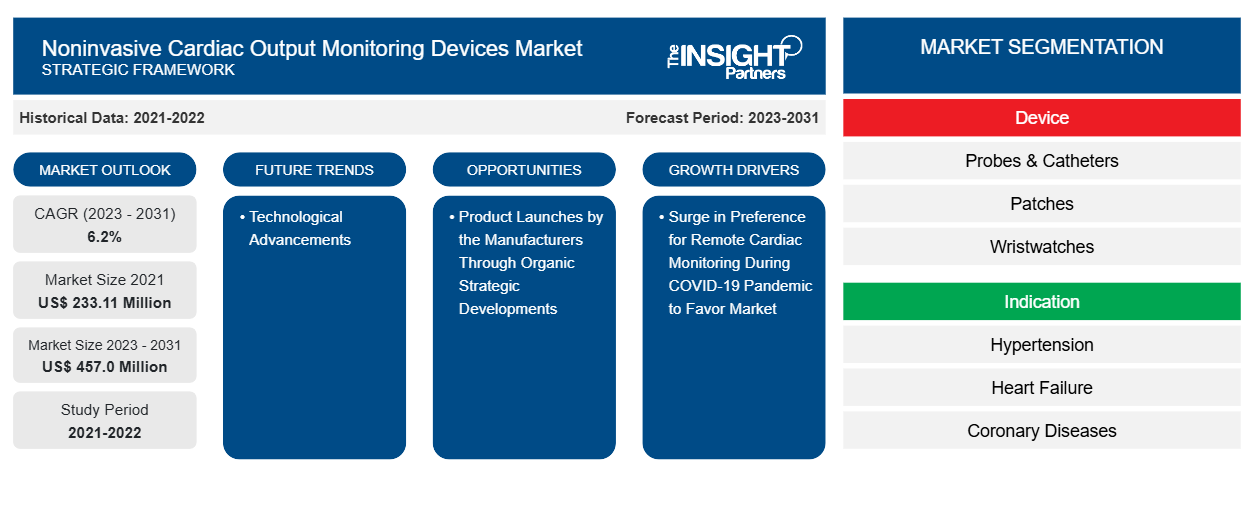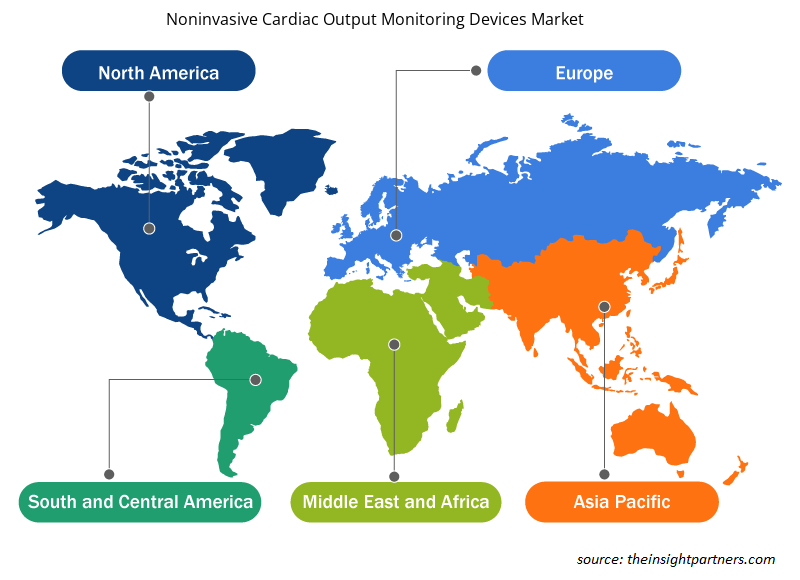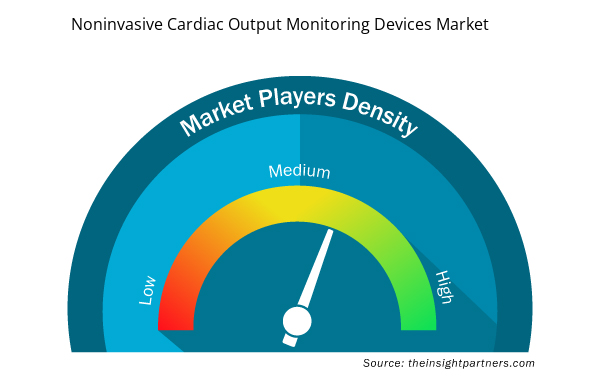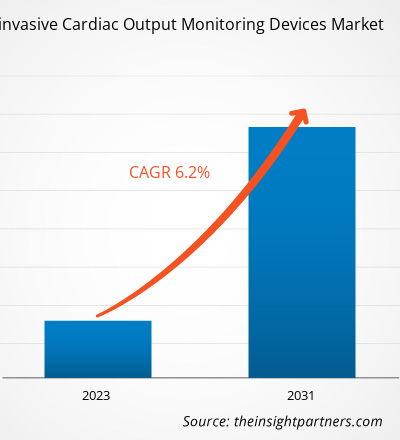The noninvasive cardiac output monitoring devices market was valued at US$ 233.11 million in 2021 and is expected to reach US$ 457.0 million by 2031. The market is expected to register a CAGR of 6.2% from 2023 to 2031. Technological advancements are likely to remain key trends in the noninvasive cardiac output monitoring devices market.
Noninvasive Cardiac Output Monitoring DevicesOverall Market Analysis
The measurement of cardiac output (CO) is essential in medical practices. In the past, invasive cardiac monitoring was the gold standard treatment for diagnostics. However, in recent years, several noninvasive cardiac output monitoring devices have been developed by the top medical device manufacturers. These devices are technologically advanced products offering alternative solutions to cardiac populations reluctant to undergo invasive cardiac diagnostic treatment.
Noninvasive Cardiac Output Monitoring DevicesMarket Overview
Technology, innovation, and smart technological solutions continue to positively influence the noninvasive cardiac output monitoring devices market growth significantly. Technological advancement is a key trend for the market growth. Novel product launches by the manufacturers through organic strategic developments will provide lucrative opportunities for the noninvasive cardiac output monitoring devices market growth during the forecast period.
Customize This Report To Suit Your Requirement
You will get customization on any report - free of charge - including parts of this report, or country-level analysis, Excel Data pack, as well as avail great offers and discounts for start-ups & universities
Noninvasive Cardiac Output Monitoring Devices Market: Strategic Insights

- Get Top Key Market Trends of this report.This FREE sample will include data analysis, ranging from market trends to estimates and forecasts.
You will get customization on any report - free of charge - including parts of this report, or country-level analysis, Excel Data pack, as well as avail great offers and discounts for start-ups & universities
Noninvasive Cardiac Output Monitoring Devices Market: Strategic Insights

- Get Top Key Market Trends of this report.This FREE sample will include data analysis, ranging from market trends to estimates and forecasts.
Noninvasive Cardiac Output Monitoring DevicesMarket Drivers and Opportunities
Upsurge in Preference for Remote Cardiac Monitoring During COVID-19 Pandemic
to Favor Market
Remote patient cardiac monitoring technologies help to reshape the management of cardiac disorders by making healthcare delivery efficient and accessible. For example, new-age technologies such as remotely managed defibrillators and pacemakers propel the demand for remote cardiac care. Cardiac remote monitoring is advancing with efficient device data management, thereby resulting in the adoption of advanced noninvasive cardiac monitoring devices. Also, there was government support to monitor vital signs remotely amid the COVID-19 pandemic. For instance, in March 2020, the USFDA announced the allowance of expanded use of devices to monitor patients' vital signs remotely. Allowing remote cardiac devices to be used remotely can help healthcare providers access information about patients’ vital signs while the patient is at home, reducing the need for hospital visits and minimizing the risk of novel coronavirus exposure. Furthermore, key medical device manufacturers have launched innovative noninvasive cardiac output monitoring devices during the COVID-19 pandemic. For instance, in May 2020, Octagos Health, a Houston-based healthcare startup company, announced the launch of a next-generation remote monitoring software platform for patients with implanted cardiac devices. The Octagon software allows healthcare professionals access to cardiac patients, pacemakers, and defibrillators using one portal. Also, the software simplifies the management of remote transmissions and simultaneously provides real-time patient insights and analytics in a secure and cloud-based platform. Therefore, the remote cardiac monitoring devices approach will contribute significantly to the noninvasive cardiac output monitoring devicesmarket growth.
Technological Advancements
Technological advancements have encouraged medical device manufacturers to design innovative products. Emerging technologies provide effective alternatives to traditional cardiac monitoring, creating alerts for patients at risk of cardiovascular disease. The Mobile Cardiac Telemetry (MCT) is an example of a technologically advanced cardiac monitoring device product. The MCT system assists in monitoring the heart conditions of cardiac patients. Patients carry a tiny sensor and monitor throughout the day. Whenever a cardiac event occurs, the MCT sends the data to a central system for analysis and response. The system generates a report containing graphs and trends and shares it with the patient's physicians for further action. MCT systems can analyze every heartbeat and detect irregularities in a patient's normal conditions, followed by initiating an immediate emergency response, which makes them one of the most preferred options for cardiac monitoring. Therefore, the adoption of such technologically advanced noninvasive cardiac output monitoring devices meets the healthcare needs of a patient, which drives the noninvasive cardiac output monitoring devicesmarket growth.
Product Launches by the Manufacturers Through Organic Strategic Developments
Manufacturers are investing in designing innovative noninvasive cardiac output monitoring devices to better connect hospitals with cardiac patients. Following are a few developments by the manufacturers.
- In June 2021, Max Healthcare launched a patient monitoring framework integrated with an artificial intelligence (AI) powered device, which is claimed to be the first in the country. Max Healthcare is one of the largest healthcare providers in India, with over 15 super-specialty hospitals, diagnostics, and integrated home care services. It has launched the AI-powered patient monitoring service in collaboration with a digital health solutions provider named MyHealthcare. The Max MyHealth+ ecosystem, built-in collaboration with MyHealthcare, has integrated blood pressure monitors, ECG and heart rate devices, and blood sugar monitoring devices.
- In May 2021, VitalConnect, Inc., a leading provider of biosensor technology for remote and in-hospital monitoring, launched the VitalPatch RTM mobile cardiac telemetry (MCT) solution. It is the only cardiac monitoring solution available with a flexible, programmable platform covering multiple cardiac monitoring needs. Uniquely and only available from VitalConnect, the platform allows for continuous, real-time cardiac arrhythmia detection while simultaneously measuring patient physiological parameters.
Such strategic activities are likely to provide lucrative opportunities for the noninvasive cardiac output monitoring devices market to drive innovation during the forecast period.
Noninvasive Cardiac Output Monitoring Devices
Market Report Segmentation Analysis
Key segments that contributed to the derivation of the noninvasive cardiac output monitoring devices market analysis are device, indication, and end user.
- Based on the device, the noninvasive cardiac output monitoring devices market is segmented into probes & catheters, patches, and wristwatches. The probes & catheters segment held the largest market share in 2023.
- By indication, the market is segmented into hypertension, heart failure, coronary diseases, myocardial ischemia and infarction, arrhythmias, congenital problems, and others. The hypertension segment held the largest share of the market in 2023.
- By end user, the market is segmented into hospitals, emergency service centers, homecare, and others. The hospitals segment held the largest market share in 2023.
Noninvasive Cardiac Output Monitoring Devices Market Share Analysis by Geography
The geographic scope of the noninvasive cardiac output monitoring devicesmarket report is mainly divided into five regions: North America, Asia Pacific, Europe, Middle East & Africa, and South & Central America.
North America dominated the noninvasive cardiac output monitoring devices market. In the North American market, the US accounts for a considerable market share. The presence of top medical device manufacturers in the US and launch of technologically advanced products by the manufacturers are among the most influential factors responsible for the market growth. Asia Pacific is anticipated to register the highest CAGR in the coming years.
Noninvasive Cardiac Output Monitoring Devices
Noninvasive Cardiac Output Monitoring Devices Market Regional Insights
The regional trends and factors influencing the Noninvasive Cardiac Output Monitoring Devices Market throughout the forecast period have been thoroughly explained by the analysts at Insight Partners. This section also discusses Noninvasive Cardiac Output Monitoring Devices Market segments and geography across North America, Europe, Asia Pacific, Middle East and Africa, and South and Central America.

- Get the Regional Specific Data for Noninvasive Cardiac Output Monitoring Devices Market
Noninvasive Cardiac Output Monitoring Devices Market Report Scope
| Report Attribute | Details |
|---|---|
| Market size in 2021 | US$ 233.11 Million |
| Market Size by 2031 | US$ 457.0 Million |
| Global CAGR (2023 - 2031) | 6.2% |
| Historical Data | 2021-2022 |
| Forecast period | 2023-2031 |
| Segments Covered |
By Device
|
| Regions and Countries Covered | North America
|
| Market leaders and key company profiles |
Noninvasive Cardiac Output Monitoring Devices Market Players Density: Understanding Its Impact on Business Dynamics
The Noninvasive Cardiac Output Monitoring Devices Market is growing rapidly, driven by increasing end-user demand due to factors such as evolving consumer preferences, technological advancements, and greater awareness of the product's benefits. As demand rises, businesses are expanding their offerings, innovating to meet consumer needs, and capitalizing on emerging trends, which further fuels market growth.
Market players density refers to the distribution of firms or companies operating within a particular market or industry. It indicates how many competitors (market players) are present in a given market space relative to its size or total market value.
Major Companies operating in the Noninvasive Cardiac Output Monitoring Devices Market are:
- Baxter,
- Bio-Beat,
- GE Healthcare,
- Koninklijke Philips N.V.,
- Abbott,
- Deltex Medical Limited,
Disclaimer: The companies listed above are not ranked in any particular order.

- Get the Noninvasive Cardiac Output Monitoring Devices Market top key players overview
Noninvasive Cardiac Output Monitoring DevicesMarket News and Recent Developments
The noninvasive cardiac output monitoring devicesmarket is evaluated by gathering qualitative and quantitative data post primary and secondary research, which includes important corporate publications, association data, and databases. The following is a list of developments in the market:
- In January 2021, OMRON Healthcare, Inc. launched its first remote patient monitoring service at the CES 2021, along with new digital health tools, to boost patient-to-physician communication and ensure active management of hypertension. OMRON introduced the first wearable blood pressure monitor as well as the first blood pressure monitor with built-in EKG in the last three years; with the innovations, it continues to transform the global heart health marketplace and support its mission of Going for Zero heart attacks and strokes.
Noninvasive Cardiac Output Monitoring DevicesMarket Report Coverage and Deliverables
The “Noninvasive Cardiac Output Monitoring DevicesMarket Size and Forecast (2021–2031)” report provides a detailed analysis of the market covering below areas:
- Noninvasive cardiac output monitoring devices market size and forecast at global, regional, and country levels for all the key market segments covered under the scope
- Noninvasive cardiac output monitoring devices market trends as well as market dynamics such as drivers, restraints, and key opportunities
- Detailed PEST/Porter’s Five Forces and SWOT analysis
- Noninvasive cardiac output monitoring devices market analysis covering key market trends, global and regional framework, major players, regulations, and recent market developments
- Industry landscape and competition analysis covering market concentration, heat map analysis, prominent players, and recent developments for the noninvasive cardiac output monitoring devices market
- Detailed company profiles
- Historical Analysis (2 Years), Base Year, Forecast (7 Years) with CAGR
- PEST and SWOT Analysis
- Market Size Value / Volume - Global, Regional, Country
- Industry and Competitive Landscape
- Excel Dataset



Report Coverage
Revenue forecast, Company Analysis, Industry landscape, Growth factors, and Trends

Segment Covered
Device , Indication and End User and Geography

Regional Scope
North America, Europe, Asia Pacific, Middle East & Africa, South & Central America

Country Scope
Argentina, Australia, Brazil, Canada, China, France, Germany, India, Italy, Japan, Mexico, Saudi Arabia, South Africa, South Korea, Spain, United Arab Emirates, United Kingdom, United States
Frequently Asked Questions
What is the expected CAGR of the XYZ market?
The noninvasive cardiac output monitoring devices market is foreseen to register a CAGR of 6.2% from 2023 to 2031.
What would be the estimated value of the XYZ market by 2031?
The noninvasive cardiac output monitoring devices market size is expected to reach US$ 457.0 million by 2031.
Which are the leading players operating in the noninvasive cardiac output monitoring devices market?
Key players in the noninvasive cardiac output monitoring devices market are - Baxter, Bio-Beat, GE Healthcare, Koninklijke Philips N.V., Abbott, Deltex Medical Limited, NIMedical, LiDCO Ltd. , Conmed Corporation, Imacor, and Other Market Players
What are the future trends of the noninvasive cardiac output monitoring devices market?
Cardiac remote monitoring is advancing with efficient device data management, thereby resulting in the adoption of advanced noninvasive cardiac monitoring devices. Remote cardiac monitoring and Mobile Cardiac Telemetry are anticipated to remain key noninvasive cardiac output monitoring devices market.
What are the driving factors impacting the noninvasive cardiac output monitoring devices market?
Upsurge in Preference for Remote Cardiac Monitoring During COVID-19 Pandemic and technological advancements such as Mobile Cardiac Telemetry (MCT) are key drivers of the noninvasive cardiac output monitoring devices market
Which region dominated the noninvasive cardiac output monitoring devices market in 2023?
North America dominated the noninvasive cardiac output monitoring devices market in 2023.

 Get Free Sample For
Get Free Sample For